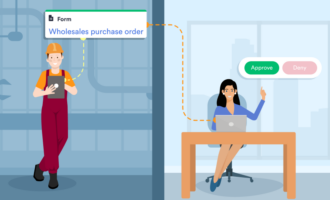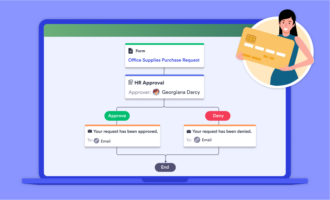Isaac Newton said it best — for every action, there’s an equal and opposite reaction. In your business, it’s your job to make sure these actions and reactions work together to help you accomplish your goals.
That’s definitely the case when it comes to a purchase requisition vs a purchase order. It’s important to know the difference between the two and how to coordinate them.
Whereas a purchase requisition is an internal document employees use to get approval for purchases, a purchase order is an official request for goods you send to a vendor. Think of a purchase requisition as the action and a purchase order as the reaction.
Understanding how to use purchase requisitions and purchase orders properly can help businesses run their operations smoothly and keep an ongoing tally of the products they have and the ones they need. Here’s how both forms can help you put your business on the right track.
Streamline the buying process
No one outside of your organization will ever see a purchase requisition. Its purpose is to establish a clear channel of communication from employee to manager about what supplies a company needs.
Once managers approve a requisition, the information goes on a purchase order, which then goes to a supplier or vendor to request products or services. A purchase order includes the quantity of supplies requested and how much you’re going to pay for them.
Following a clear and thorough purchasing process will help your business organize your procurement process and ensure nothing gets lost in translation. Plus, once a transaction is finished, you’ll have a complete record of each step in case you decide to place a larger order or set up repeat purchases in the future.
Create separate workflows
An organized company operates more efficiently than a disorganized one. If your business doesn’t have a clear system for recording purchases, it’s pretty easy for these details to get lost. That’s where the different components of a purchase requisition vs a purchase order are helpful.
The information included in a purchase requisition is specific to your company. If you have a busy season coming up and you need to boost your supply of a given material, you can use a purchase requisition to specify what type of item you need, who you’re going to buy from, and when you need to buy it.
Once a requisition goes through the proper approval channels, you’ll use this information to fill out a purchase order so you can reach out to the appropriate vendor and get what you need. You can set up a different approval process for the purchase order itself — which will run more smoothly since you’ll have worked out the details while approving the purchase requisition.
And that’s where the two forms intersect and work together. For example, a company that sells factory equipment to a snack manufacturer can keep track of the purchase orders that manufacturer has filed, while the manufacturer can keep internal records of what equipment it needs and when.
Establish a better culture and reputation
Using purchase requisitions and purchase orders correctly creates a culture of better communication and cooperation.
Defining how your business approves a prospective order — and who has the authority to approve it — eliminates confusion in the process and creates a more streamlined workflow. Instead of managers exchanging several emails with their team to access purchase order information, they can go straight to a database and look up the appropriate data.
What’s more, on the purchase order side, approaching a vendor with clear documentation boosts your reputation. If your purchase order form is missing information, it’s going to delay the delivery of your goods and harm your ability to do business.
Businesses that have everything in order bolster relationships with their vendors — after all, the more precise your request, the better. You want the businesses you work with to leave each transaction with a good impression. Being organized and prompt with your forms can keep everything moving and ensure you get your supplies on time.
Master your business operations
Keeping proper records means that when a question arises, you can answer it at the drop of a hat. If an employee needs to know when to expect critical supplies, you can look up a purchase order to see its filing date and any communication you’ve had with vendors.
That’s another thing a purchase requisition and a purchase order have in common. Direct and clear access to the status of requests eliminates the potential for duplicate orders and other purchasing mistakes. The same is true for a purchase requisition — a system that takes stock of necessary items and outlines who’s responsible for approving orders speeds up the process and reduces uncertainty.
The correct approval measures ensure you have accurate records and that they’re in the right place. Plus, with the right database filing system, you can quickly access any order information for reference or analysis.
Level up your purchasing process with Jotform
When you’re buying and selling a large volume of products, it’s hard to stay organized without the proper systems in place. Attempting to keep manual paper records isn’t going to do you any favors. That’s where Jotform can help.
Regardless of whether you need a form for a purchase requisition or a purchase order, Jotform has you covered. Using Jotform’s customizable online forms eliminates the need for paper forms and the risk of losing important order information.
With the Assign Forms feature, you can quickly delegate forms to your procurement officers to kick-start the process, putting the days of countless reminders and paper records in the rearview mirror.
Even better, with Jotform Approvals, you can create approval workflows to establish a clear process for generating and completing purchase requisitions and then turning them into purchase orders. You can even assign specific approval permissions to employees.
Jotform Inbox makes communication easier, so you and your employees can process requests and track assignments in a centralized location. Plus, the Jotform Mobile Forms app allows you to work on the go.
Keeping track of inventory, the items you need to order, and your product expenses is one of the best ways to keep your business moving and consistently meet your goals. Every business owner wants their purchase workflows carried out as seamlessly as possible. When you use the proper tools and platforms — like those from Jotform — to steer your operations, you’ll create fewer headaches for yourself and your employees.
Photo by fauxels from Pexels
















Send Comment: